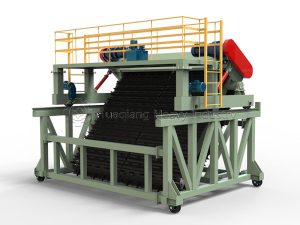On the path towards sustainable development in the oil palm industry, efficiently handling the vast amounts of agricultural waste—Oil Palm Empty Fruit Bunch (OPEFB)—has always been a core challenge. Traditional composting methods struggle with this material due to its coarse fibers and bulky, porous structure. The emergence of the chain compost turner provides a specialized solution for such difficult-to-process materials, becoming a key (key tool/solution) for realizing the resource utilization of OPEFB.
The structural characteristics of the chain compost turner perfectly match the physical properties of OPEFB. OPEFB features long, coarse fibers, is loose and porous, yet its tightly bound structure makes it hard to break down. The chain compost turner employs a robust chain plate transmission mechanism, consisting of a powerful drive unit, heavy-duty chains, and a series of regularly arranged turning plates. As the machine moves along the fermentation trough, the high-speed operating chain plates “cut” deeply into the several-meter-high OPEFB windrow with significant mechanical force, forcibly breaking up clumps of fibrous material, lifting them, and then dropping them from a certain height.
This unique working method brings multiple key benefits to OPEFB composting:
The powerful mechanical force effectively breaks down the OPEFB fiber structure, increasing the surface area and promoting microbial colonization and decomposition.
The resulting parabolic curtain of material ensures thorough aeration, which is crucial for composting, guaranteeing that aerobic microorganisms receive sufficient oxygen—vital for decomposing the high lignin and cellulose content in OPEFB.
The process achieves uniform mixing of the material, ensuring that fermentation inoculants and moisture are evenly distributed throughout the bulky OPEFB pile, preventing the formation of local anaerobic or dry zones.
Compared to other turning equipment,such as simple compost turner the chain compost turner demonstrates significant advantages when processing OPEFB:
Its sturdy construction withstands the abrasion and potential wrapping of OPEFB fibers, ensuring long-term stable operation.
Its powerful drive system guarantees effective breaking up of tightly compacted OPEFB clumps.
The rail-guided travel mode makes it suitable for large-scale trough composting systems, meeting the needs of palm oil mills to process massive volumes of OPEFB.
In conclusion, the chain compost turner is not only a technical guarantee for successful OPEFB composting but also a crucial engine driving the transformation of this agricultural “waste” into a “resource” for the oil palm industry. With its robust steel structure and precise operation, it converts a troublesome agricultural waste into quality organic fertilizer for soil amendment, providing a practical technical pathway for the green circular economy within the oil palm industry.



